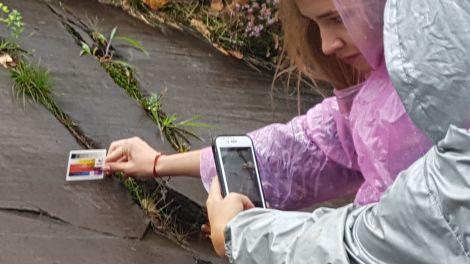What’s new in V2 and V2.1?
Scale bar: The scale is now 8 cm! We’ve also pushed the scale bar right up against the edge so it can be used like a ruler and added a mm bar scale.
Iron crosses: The box around the iron-crosses is now 35mm. This is helpful for those who use a local coordinate system.
Printing: We’ve changed the material for better colour accuracy. The material is also more flexible to wedge it into those rock crevices and thinner to fit more scale cards in your wallet
FRONT
Features:
The size of a business card so that it fits into the standard wallet.
Grayscale for white balance post-processing correction.
Colour chart to standardize colour descriptions of visible pigment. Used like a Munsell colour system, we can now describe colours to each other that we will all be able to reference and verify.
Back
Iron-crosses for photogrammetry. Most Structure-from-Motion (SfM) photogrammetry software allows for the automatic detection of these crosses. By providing a known distance, it can simplify scaling of rock art panels.
Frequently Asked Questions
1. What if the colour is not in the colour chart?
Like a Munsell, fractions can be used to describe in-between colours. Please let us know if there is any colour you feel needs to be included in the chart.
2. Is 4 cm distance for a photogrammetry scale too short?
Depends on the subject. It should be sufficient for figures and panels that are a few square-meters in size. We encourage using several scales at different orientations for a more accurate model. If recording the entirety of a larger site by photogrammetry, sticking two of these cards to a ruler will be more effective.
3. How did you pick the colours in the colour scale?
These were identified by the PERAHU team as the most common colours found in Australian rock art, and we incorporated feedback from various colleagues and testers from our version 1 prototype.
4. What are the colours references?
The colour names, hex codes, RGB values and other information are available here.
5. Why are different shades of blue included?
At some sites in Australia, Reckitt's blue (washing dye) was used to make a paint after being obtained from European settlers. So it is a useful colour for Australian rock art.
6. Will there be updates?
Yes, the current card is version 2.1. We will gather feedback and possibly incorporate changes into the next version. Please let us know if you have any suggestions.
7. Where can I get one?
Email us at perahu@griffith.edu.au.


